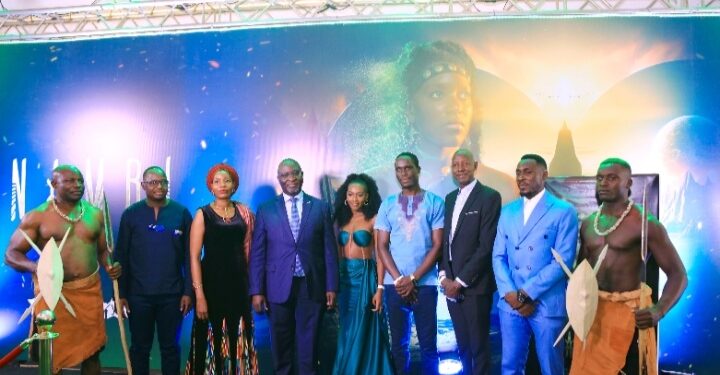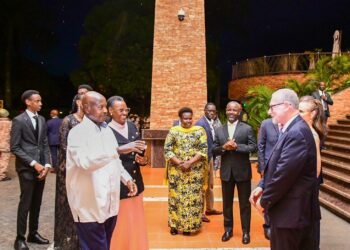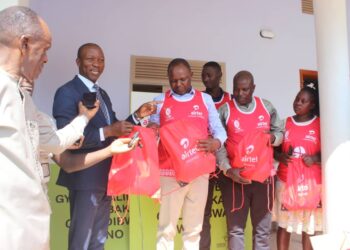There is a tendency to tell Ugandan stories from the same point of view. The danger in this, it boxes art, the very attribute that is at the heart of filmmaking. Stories are best told when they are given different nuances.
Which is why Nambi, a reimagined story of the popular Buganda folktale, is an important step in the evolution of Uganda’s film industry.
In its nature as a mythology, the story around Nambi, daughter of the heavenly deity Ggulu, is fictional. Thereby giving those telling it the artistic freedom to use all sorts of visuals to bring it to life.
And Peter Mukiibi who directed the short film that was premiered on 30th May 2023 did not hold back at exercising this artsy and compelling freedom.
Nambi is based on the mythical story of the creation of Uganda. The story begins with Kintu, the first man, wandering Earth with only his possessions on him and his cow.
Then one day, another creature – a woman – suddenly drops down from the heaven. This woman is Nambi who also happens to be Kintu’s younger sister. They get to know each other but soon enough, Nambi returns to heaven leaving Kintu longing to see her again.
Millions of Ugandans have learnt this legend in school, through books and in stories told around the fireplace.
But this is the first time it is told in a 30-minute compelling motion picture. To depart from the basic format that local productions are used to, Nambi applied VFX (visual effects) creating futuristic imagery of Ggulu (heaven) using CGI, Compositing and Motion Capture.
Arthur Nakaka led an all-Ugandan team of seven talented 3D artistes to bring this story to life. Most of them have grown up watching Marvel movies, so, for them it was an opportunity to actualize the fantasies that have lived in their heads for a long time.
To achieve a heavenly impression, they digitally built modern architectural structures along with a towering ancient statues and rock cliffs. The architecture also incorporates Ugandan-style grass thatched hats that are common in Northern Uganda. The different features are connected through wooden suspension bridges.
Ggulu also has natural environs like trees, water and birds.
Unlike the colonial-imparted depictions of the likeness of God (as white), the setting and cast of Nambi seems to reaffirm the contrary – that Ggulu (God) is African. The film scores highly in its attempt to tell African stories the African way.
While the story is about creation, the film tackles other themes like culture, love, survival, identity and power struggles
Doreen Nabbanja (Kafa Coh and Mistakes Girls Do) plays Nambi, a role she says she initially felt was too big for her given its historical significance. Naturally, she is a theatrical person who speaks with her body. But Nambi, a god, was to do no such thing. Even though adjusting to such a calm demeanor was difficult, her portrayal was a good performance.
The Kintu character (portrayed by Bint Kasedde) is a representation of pre-civilization Uganda characterized by a lifestyle of hunting and gathering. He wears no cloth except for a piece of bark cloth around his hip and lives in a cave where relies on traditional means such as rubbing a wooden shaft to make a fire.
The lives of Kintu and Nambi couldn’t be starker. The former representing the past while the latter is a symbol of the future.
Through the dialogue (in English, Luganda, Swahili and Dutch), setting and crew, the creators of Nambi seem to portray how further the legend has traveled beyond Buganda and Uganda. The film opens in a household in modern day Belgium where two Belgian children are listening to their grandmother narrate the story of Kintu to them. An attempt to debunk the notion that Western mythologies hold more superiority. In so doing, not only preserving Ugandan culture but drawing the world’s attention to it.
This does not only preserve culture, but it also inspires more storytellers to retell in ways never used before.
Dennis Arthur Abwakat who produced Nambi says the story of Kintu “is the most told folktale in Buganda and Uganda” and that “we wondered why there was a gap with very raw authentic stories”
“It’s quite unfortunate that nowadays you meet children and they don’t know these stories. We need to keep our roots; we shouldn’t forget our identity. That’s the reason why we have Nambi”
Abwakat produced the film alongside Usama Mukwaya and Solomon Otto.
Kintu’s geographical ecosystem is set in Moyo district and captures Uganda’s scenic landscapes, greenery and plentiful natural resources. Whichever creation theory the viewer believes in, Kintu is and is a true representation of the things that inspired the creation of Uganda. The choice of Moyo instead of any other location in Uganda, was informed by the areas virgin landscape with little signs of human settlement, which was essential if you are to tell the story of the first man on earth.
Some of Uganda’s myths have been passed on to different generations through art. Among them paintings found in caves in Nyero (in Kumi), Tororo and Sir Samuel Baker Fort (Gulu). But for those that can’t be able to see them physically, film provides a powerful medium for amplifying these stories to wider audiences as well as preserving them longer.
The cast includes Michael Musoke (who voices Ggulu), Opio Moses Isingoma (Walumbe) and Jenkins Joel Mutumba (Kayikuzi) among others.
For a project of this magnitude to be successful, it would require collective efforts from the brainy. Little wonder that the credits feature Kemiyondo Coutinho (script editor), Joe Kahirimbanyi (music), Sharpe Ssewali (music and AD) and Ekuka Izaek who has also been cinematographer on Tembele, Stain, Kafa Coh, When You Become Me and Kyenvu. Altogether, the crew was 75-people strong, which goes to tell the lengths to which the producers went to tell this story.
How do you dress a man who lived on earth 10,000 BC? Let alone those who live in heaven. Costumes are essential in such a story as they put an image to the legend. Maria Mukiibi, the costume designer, ensured there was a distinction between the characters in Ggulu and Kintu who was on earth.
Nambi for example wears costumes and accessories like golden jewelry that symbolize wealth. Unlike Kintu, she along with the other occupants of heaven, has green eyes. This, according to Abwakat, is deliberate and symbolic of how the people of heaven are not bound by time. They are not in a linear time frame.
Except for Walumbe (Gguru’s son and angel of death) who upon his appearance on earth wears a tattered robe and is armed with a blood-stained machete.
At the Nambi premiere, organized by MultiChoice Uganda, many attendees applauded the team behind the film. Many said it heralded a new way of telling Ugandan stories.
And Rinaldi Jamugisa, the PR & Communications Manager at MultiChoice Uganda agrees as much. Explaining the rationale behind the Pay-tv’s involvement in the premiere, he said projects like Nambi tie into MultiChoice’s vision of promoting local content and being Africa’s most loved storyteller.
“This particular year, the theme we are running with is ‘Uganda in Action’, because we know Uganda has many creative minds and great stories to tell. Back in the day, films were different. But the advent of technology and the innovative ways to deliver stories to audiences, it’s something that we need to be proud of,” Jamugisa said.
Do you have a story in your community or an opinion to share with us: Email us at editorial@watchdoguganda.com













